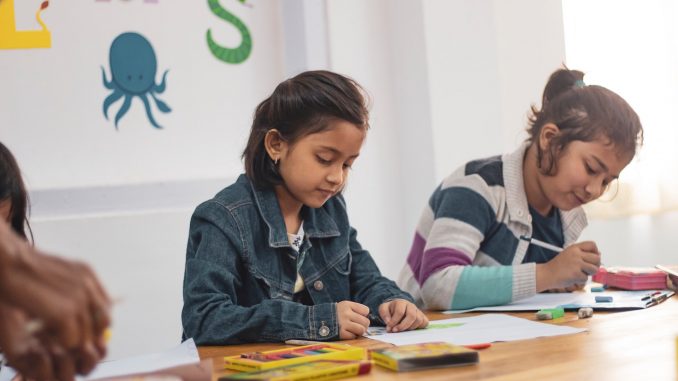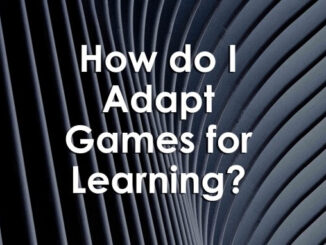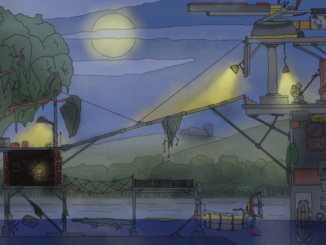
Play, entrepreneurship, and management are concepts in business. Risk-taking, changing habits, and cognitive and creative rigor stem from these big three.
Playing games and creating games not only can teach high-level concepts but also build collaborative learning skills. Creating games develops rigorous learning connections to entrepreneurship, innovation, and the iterative cycles of business development. This Entrepreneurial Ludic Learning ™ I believe will create environments of learning and livelihood that will transform education and the workplaces of the future.
The instructional pedagogy of gaming and game creation and their systems used in my high school business classrooms are compatible and reproducible in any classroom. They also have worked in my management consulting and personalized education endeavors. In short – they work!
The news is filled with headlines of teachers in the United States leaving the profession of education en masse, teacher labor strikes or shortages, underperforming schools, and conflicting curriculum goals.
Yet every day, countless teachers are making magic in their classrooms, from urban to rural, affluent to impoverished; and these teachers, some with little to no knowledge of business process analysis, are doing just that! They analyze, they incentivize, they deal with human resources issues and motivation and continue to be productive.
Play – Entrepreneurship – Management; three words that most people would not put together when speaking about education; however, in my tenure as an entrepreneur coach, instructional developer, adjunct professor, athlete and coach, singer and performer, and teacher of Business and Career Education and Social Studies with over 30 years in classrooms, board rooms and server rooms, I have worked to empower my students and clients by teaching innovation, iteration and integration through project and problem-based learning and gaming and I have seen its results firsthand!
Not only are these three words, Play – Entrepreneurship – Management connected, but optimal in learners’ deep understanding of the oftentimes difficult and unfamiliar vocabulary of vocational or any of their studies.
We want to make students college and career ready? I daresay then we better start playing MORE!
We are inherently problem-solvers by nature. We are curious and crave connections. We love to play.
Gaming is the ideal platform to make learning “stick”—to afford students deeper leveling, broader reaching, and easier recalling of curricular concepts.
Like gum under a desk, students (from birth to adulthood) use games, play, and the iterative methodologies to not only form good learning habits, but also to transform themselves into managers of their own learning, entrepreneurs of their ideas and players of a self-determined future—the sticky learning concepts we all epitomize.
So why don’t we play more?
Perhaps the educational systems in the United States are stuck in a poorly translated world where the definition of a game – loosely translated from German, is “any activity which is executed only for pleasure without conscious purpose.”

The “former” models of U.S. education are very rigorous. There can’t be pleasure and fun in education! We most definitely can’t do anything without a conscious purpose!
Well then why, as we look to the Finnish model, do they hold “ the unofficial title as the country with the world’s best education system since 2000?”
“Finland also has the smallest gap between the weakest and strongest students in their educational system.” (Staff, Math & Movement & Hancock)
Why? Perhaps it is in that the Finnish model of education that focuses on the importance of ‘play’ and ‘joy’ in education.
And maybe, as purported by Jane McGonigal, everyone from HR Directors and Superintendents would be serving our world better by looking at the skill sets that gamers hold that will be ideal in not only transforming the workforce of the future but also energizing and improving outcomes of educational systems based in an agrarian model that no longer exists for most.
The workplace learning skills of McGonigal are:
Blissful Productivity
Urgent Optimism
Social Fabric
Epic Meaning
McGonigal believes that these four things cannot only create happier workplaces, more productive and collaborative employees but also a better world.
So we need to BUSE it up in the classrooms and workplaces, to increase joy, optimism, connections and meaning though gaming.
In addition, entrepreneurship (or as I view it, game based learning) needs to be accepting that there will be failure. RISK is inherent in creativity and without creativity there will be no change.
This is why Entrepreneurial Ludic Learning™, MUST look to the iterative process of the production cycle of business and game play to allow our students (the employees and entrepreneurs of the future) the creative and productive outputs that will make learning stick.
So why have we driven risk taking and failure from learning? Why has the four letter word RISK become so bad especially in the education world?
Let’s look at why risk and failure has been cast out of education.
Do we like failure? The simple answer, NO!
My question then is why not?
It hurts. It makes us look bad.
This is where cognitive theory kicks in.
In discussing gaming and learning with my “crew” (A group formed from the onset of the Games in In Education Symposium in the Capital District of NYS that encompasses teachers, game developers and business people.) and oftentimes we speak of the challenges of the neurotypical mindset as non-neurotypical learners. We also wonder if non-neurotypical is a better way of creating challenging material and improving education for all.
What can we learn from non-neurotypical learners? Are all learners non-neurotypical but conditioned to be neurotypical through habit? How can we break the habits to form better neurological connections?
Malcolm Gladwell calls them “Outliers,” business teachers call them innovators (entrepreneurs), cognitive scientists call them non-neurotypical, and historians call them rebels.
Perhaps more simply put, some, no, many people enjoy coloring outside the lines in a world full of boxes drawn in permanent marker.
We speed just a little bit. We put just enough coins in a parking meter and try to stretch out a minute or two more. We show up at 7:20 am for a 7:30 am appointment…
So if most people want to take risks, why don’t we call it that? Why don’t we fess up to wanting to make mistakes and own them when we make them?
Why are schools encountering more and more students that are non-neurotypical or on the autism spectrum?
According to the Autism Society: “Prevalence of autism in U.S. children increased by 119.4 percent from 2000 (1 in 150) to 2010 (1 in 68). (CDC, 2014) Autism is the fastest-growing developmental disability… and its prevalence has increased by 6-15 percent each year from 2002 to 2010. ”

How do we, as teachers encountering more and more students that are non-neurotypical, (Note: Non-neurotypical learners are students most commonly placed on the autism spectrum but this term can be used with any student that does not benefit from or has difficulty with learning in traditional ways.) address the learning needs of the increasing number of students presenting with these learning types while allowing those who enjoy the structure of neurotypical lessons and procedures through either preference or as I dare say “habits,” create engaging and robust lessons?
Well, by incorporating gaming of course!
When in the 1950’s Professor Leon Festinger’s in his groundbreaking book, Theory of Cognitive Dissonance stated, “when there were discrepancies of opinion or ability among the members of a group, pressures arose to reduce such discrepancies.” He also wrote:
Dissonance results when an individual must choose between attitudes and behaviors that are contradictory.
Dissonance can be eliminated by reducing the importance of the conflicting beliefs, acquiring new beliefs that change the balance, or removing the conflicting attitude or behavior.
We feel the pain. We don’t like it. So we do everything in our power not to feel it. We push away anything that is different to “fit in” or to just make the pain go away. We habitualize our experience to create habits.
We may not like doing things the way everyone else does them, but we crave acceptance and hate the pain so we have engaged in learning methods that may not be the best for us.
We then take that learned experience about risk avoidance from schools into the workplace.
We fear taking risks because we fear condemnation, losing jobs and/or status. It can create toxic work cultures.
As an organizational management consultant, I have been involved in workplace improvement projects that take a year or more due to the resistance to change cellularly ingrained in our being.
If we want to create the employees and entrepreneurs of the future, how does this cognitive dissonance thwart discovery, inquiry, and change in the educational setting?
How do we go from the scientific, exploratory and risk-taking toddlers to the fear-filled, settlers of the status quo?
How does this subversion of creativity and discovery learning from our childhood continue onto the workplace?
How do we, in turn, address this shameful statistic that “35 percent of young adults (ages 19-23) with autism have not had a job or received postgraduate education after leaving high school”(Shattuck et al., 2012)?
To me, students are just employees and entrepreneurs in training. Their ideas, suggestions and prior learning MUST be valued, acknowledged and, painfully at times, corrected if we are to create the social change agents and entrepreneurs of the future.
We must teach them about cognitive dissonance and about the pain that comes with failure without stifling the growth and creation that can spring from it. (Festinger)
We are told, by administrators, the public, and the media that as teachers, we should create a learning environment that creates a safe and productive learning place for all of our students.
So how do we accomplish that with the oftentimes limited financial resources, oversized classrooms and over-taxed time schedules of teachers, students, and families?
My answer came by developing a business process analysis model for educational purposes through gaming after asking myself the question, “How can I pull my unique knowledge of organizational management, employee motivation, and the habitual nature of what makes worksplaces successful and games fun and use it to make my students’ ‘user experiences’ better?”
Businesses of learning—make no mistake, school is business. Not-for-profits are still businesses and therefore need to be viewed through a business mindset.
How can we as teachers utilize the boundless studies on workplace performance to assist us in helping our students be better learners? We want them to enjoy learning, to crave more of it, not see it as an enemy. We want to produce a service (education) that more and more customers crave and create a positive experience when engaging in it.
We as teachers need to take risks, and to allow our students to do the same in a safe environment to change the oftentimes bad habits of education.
In other words, we need to PLAY GAMES!
So I hit the books. I dug out my undergraduate business textbooks and articles. I researched successful business leaders and the brain based learning theories that they engaged in to change bad habits and improve their users’ (employees’) experiences. I talked to my friends and colleagues.
Paul O’Neill in October of 1987 as the new CEO of Alcoa decided to make a small but substantive change in the way Alcoa did business. He decided to focus on worker safety. That was relatively unheard of in those days of fierce Japanese competition within the metals manufacturing industry. That one “small” change led to a quintupling of Alcoa’s profits.
In a nutshell, Mr O’Neill changed habits.
Schools, and by extension, teachers, are like airplanes. Oftentimes there are problems with the inner workings that cause the oxygen masks to fall from the ceiling.
Discipline problems, unsafe home lives of our students, substance abuse, truancy, cheating, absenteeism, tardiness, disruptive behaviors—all of these are things that individually can send a plane down and when multiplied, can bring the plane and our oxygen masks from the ceilings.
Our first reaction is to put the oxygen mask on our students. But as everyone knows from the demonstrations on the airplanes putting YOUR oxygen mask on first, allows you to have the strength to give O2 to help those around you.
But how?
Focusing on righting the airplane by focusing on teachers FIRST. Taking business concepts of caring for your employees, creating a positive work environment that is safe and secure and FUN!
“It should go without saying, if the person who works at your company is 100 percent proud of the brand and you give them the tools to do a good job and they are treated well, they’re going to be happy,” “If the person who works at your company is not appreciated, they are not going to do things with a smile,”
– Richard Branson tells Inc. president and editor-in-chief Eric Schurenberg.
How do you get that smile? How do you get teachers to feel as if they matter and that they are valued?
In our professional meetings we need to play games. We as teachers need to learn more about how playing games affects learning and we need to listen to business learners and entrepreneurs, watch TED Talks and continue to learn about how game theory can improve user experiences.
Ok, I know, I know…it seems crazy, but I have questions about when you play games in your classroom be it online, teacher directed “Kahoot” or “Jeopardy” type, or just letting your students play a card game like “Uno” during free time or recess.
What do your students look like? Are they smiling? Do they push through frustrations after losing a game and try again? Are you smiling and happy?
Isn’t this what we want our students to do in their learning? Isn’t this what YOU want to be doing?
Let us take it one step further now. Imagine having the student, who may not be engaged in the lesson, but who you observe drawing beautiful pictures. They obviously enjoy that and have a talent. Why not engage that talent into creating a game with a team of others in the class?
Why not have them take the learning objectives and concepts of the content and create a game?
Let your students naturally figure out who is good at what, figure out what game modality would best address the content, create a materials list, storyboard the game play, collaborate to find the answers, and present that to other students by developing the rules for their game along with the finished product.
They can briefly explain their game in a roundtable or direct presentation style to the others in the class and let the other students do an analysis of their playing experiences with tips to the creators as to how to make it better and thereby engage in a peer analysis.
Then take it a step further—ask other teachers and/or parents/members of the community to sit on a panel of investors and have these student creators pitch their game to them.
Cognitively robust, collaborative, and creative are the three phrases that come to mind in that educational exercise as well as play, entrepreneurship, and management.
Through play, gaming, and game development, students engage in entrepreneurial, collaborative, and creative processes and learn self-and team-management techniques.
Through learning through play and game-creation they hit upon every Level 4 in Danielson’s Framework For Teaching.
So take a risk, play “Risk©,” encourage risks in your classroom.
Gaming is a great tool to change habits, improve learning outcomes, and prepare students for the future workplace. Let’s play!
References and further reading:
Baer, D. (2014, April 9). How Changing One Habit Helped Quintuple Alcoa’s Income. Retrieved from https://www.businessinsider.com/how-changing-one-habit-quintupled-alcoas-income-2014-4
Danielson, C. (2013). The Framework for Teaching Evaluation Instrument. Retrieved from https://usny.nysed.gov/rttt/teachers-leaders/practicerubrics/Docs/danielson-teacher-rubric.pdf
Duhigg, C. (2014). The power of habit: why we do what we do in life and business. New York: Random House Trade Paperbacks.
(2015, August 26). Facts and Statistics. Retrieved from https://www.autism-society.org/what-is/facts-and-statistics/
Games in Education Symposium. Retrieved from http://gamesineducation.org/
Hancock, LynNell. “Why Are Finland’s Schools Successful?” Smithsonian.com, Smithsonian Institution, 1 Sept. 2011, http://www.smithsonianmag.com/innovation/why-are-finlands-schools-successful-49859555/
Gladwell, M. (2008). Outliers. New York, NY: Little, Brown and Company.
Oppong, T. (2018, June 15). The Neuroscience of Change: How to Train Your Brain to Create Better Habits. Retrieved from https://medium.com/swlh/to-break-bad-habits-you-really-have-to-change-your-brain-the-neuroscience-of-change-da735de9afdf
Raymundo, O. (2014, October 28). Richard Branson: Companies Should Put Employees First. Retrieved from https://www.inc.com/oscar-raymundo/richard-branson-companies-should-put-employees-first.html
Roth, M. (2012, May 13). ‘Habitual excellence’: The workplace according to Paul O’Neill. Retrieved from https://www.post-gazette.com/business/businessnews/2012/05/13/Habitual-excellence-The-workplace-according-to-Paul-O-Neill/stories/201205130249
Staff, “The World’s Best Education System Uses Play-Based Learning.” Math & Movement, MATH & MOVEMENT 215 N. Cayuga Street Ithaca, NY 14850, 4 Oct. 2018, http://mathandmovement.com/finland-education-system/
- Games, Business and Changing Times - 12th November 2021
- Entrepreneurial Ludic Learning - 17th February 2020





Very nicely framed, Kathy. And it addresses a lot of issues around children, failure and risk. These children are the same people who become the adults in the workplace and learning how to learn and to deal with change are very important lessons for our society. We structure so much education as winner / loser, with grading kids on a scale anchoring the belief that competition is the key to organizational success.
The reality is that COLLABORATION is a real key in most successes, that teams and people working together can accomplish so much more. Competition measurably suboptimizes performance in so many situations and works directly against creativity and innovation.
For 25 years, I have played with this cognitive dissonance framework of Festinger, and it is really easy to see it in action. When some process or issue gets framed as a Square Wheel®, people immediately go into a problem solving mode to identify some Round Wheel. When only one person is working on things, it generally produces ONE idea for improvement. But when a small group of people are playing with ideas, the creative ideas and the cognitive dissonance around the assumption that there is a Round Wheel out there drives more dissatisfaction with the way things are now. This is a motivating force for change and improvement for work teams (and leadership).
Have FUN out There!
Super article, Kathy. I really like the section about how games can help learners who are non-neurotypical. I think my ADD is a direct cause of my interest in learning games, because of the way that games allow me to try new things, to explore in numerous different ways and to exercise creativity without consequences, in a way that the reral world often doesn’t. I think this would be an interesting research area – how play can support neurodiversity in learning situations.
A useful link about Internet safety for people with Autism Spectrum Disorder was shared with Ludogogy.
https://www.wizcase.com/blog/internet-safety-guide-for-people-with-autism-spectrum-disorders/#8